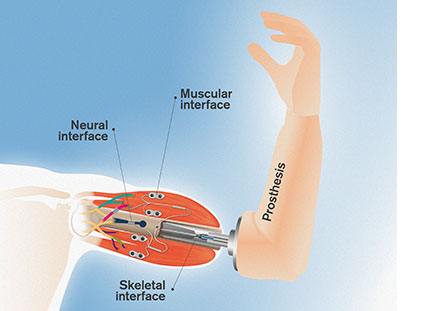Way back in January, before the novel coronarvirus had achieved pandemic proportions, technology soothsayer David Cearley mentioned smart prosthetics in his annual forecast of the coming year’s most impactful tech trends. “We’re moving from designing for humans to architecting humans themselves,” Cearley noted, while listing smart prosthetics within the broader category of “human augmentation.”
You could argue that smart prosthetics already exist in the form of microprocessor knees and myoelectric arms, and you wouldn’t be entirely wrong. But Cearley tabbed 2020 as a potential breakthrough year, in which prosthetic technology might converge with advances in artificial intelligence, cognitive computing, and RFID signaling to produce a fundamentally new class of super-smart limbs. These genius devices promise to integrate with both body and mind, providing a degree of sensation along with advanced motor control.
With nearly three-fourths of the year in the books, that prediction looks more like a hit than a miss. Despite the disruptions wrought by COVID (which Cearley had no way of anticipating when he made his forecast), momentum continues to build on multiple fronts toward the development of prosthetics that pair feeling with function. Here’s a brief progress report:

Retraining Peripheral Nerves with AI
At the University of Michigan, a team of surgeons and computational scientists have pioneered a new procedure that captures electrical signals from nerves severed during an amputation and uses them to guide a prosthetic hand via artificial intelligence.
“People for many, many years have tried to get prosthetic control down from a nerve,” says Cynthia Chestek, one of the team’s biomedical engineers. “But the physics is just terrible. It’s very hard to record these very small [nerve] signals, and usually it’s not the signal that you want.”
The Michigan surgeons found they could amplify the signal by wrapping the peripheral nerve ending in a small piece of muscle tissue. Chestek’s engineering team developed machine-learning algorithms to channel those signals into finely calibrated movement.
“We’re using a lot of the same sort of algorithms that are under the hood of autonomous vehicles,” she explains. “But what’s new is that patients are able to control the position of their fingers better. We were able to show our participants positioning the point of their thumbs in two dimensions, and that’s really useful if you’re trying to pick up things. If you can’t orient your thumb around an object, it’s very hard to grasp anything.”
The surgery works on any type of amputation, Chestek adds. Read the full paper in Science Translational Medicine.
Putting Skin in the Game
Researchers at RMIT University in Australia announced a major breakthrough earlier this month: an electronic artificial skin prototype that reacts to pain just like real skin, paving the way for prosthetics that can relay sensory input to the brain and learn to recognize patterns over time.
“It’s a critical step forward in the future development of the sophisticated feedback systems that we need to deliver truly smart prosthetics and intelligent robotics,” says Dr. Madhu Bhaskaran, the project’s lead researcher. One of Bhaskaran’s colleagues, Dr. Md Ataur Rahman, adds: “Our artificial skin knows the difference between gently touching a pin with your finger or accidentally stabbing yourself with it—a critical distinction that has never been achieved before electronically.”
Like your regular skin, RMIT’s prototype can discern varying levels of temperature, pressure, and touch. It also can learn through experience, using electronic memory cells that imitate the way the brain uses long-term memory to recall and retain previous information. “We’ve essentially created the first electronic somatosensors,” Rahman says, “replicating the key features of the body’s complex system of neurons, neural pathways, and receptors that drive our perception of sensory stimuli.”
Read the full paper in Advanced Intelligent Systems to geek out on all the details.

Doing It With Feeling
The New England Journal of Medicine reports on a mind-controlled arm prosthesis that ranks as “one of the world’s most integrated interfaces between human and machine.”
Developed primarily at Chalmers University of Technology in Göteborg, Sweden, the devices are called “neuromusculoskeletal prostheses”—that is, they articulate with bone, muscle, and nerves. Based on the OPRA implant system developed for osseointegration, the high-tech device anchors directly to the residual bone. Electrodes implanted inside the residual limb establish communication between the prosthesis and the brain, relaying signals in both directions.
The core innovation, according to lead researcher Max Ortiz Catalan, is the creation of “neural interfaces that can seamlessly transmit large amounts of artificially collected information to the nervous system, in a way that the user can experience sensations naturally and effortlessly.”
“The traditional socket prosthesis I had before was a tool I wore,” says one of the study’s patients, who has been wearing a prototype for the last two years. “The new prosthesis does not feel like something I wear, but [more like] a part of me.”
Catalan and his team have spent 2020 scaling up their clinical study, with the goal of making the product widely available to arm amputees within two years. They are also developing a leg prosthesis that’s based on the same principle.
Get more details at Science Daily.

Plumbing the Depths of Octopus Aptitude
The year’s most exotic news comes from the Michigan State University, where neuroengineer Galit Pelled has launched a novel investigation into the mechanisms by which octopi control their eight limbs. The National Institutes of Health ponied up an eye-popping $2.35 million for Pelled’s work, describing it as an exceptional study that holds “the potential to inspire an entirely new field of design.”
“Each arm of an octopus contains an axial nerve that functions like a vertebrate’s spinal cord, yet with a limitless range of movement,” explains Pelled. “This is why the octopus provides an unparalleled model to study central sensorimotor circuits associated with grasping behavior. If these movements can be described in mathematical terms, it may be possible to create a prosthetic that a person could control with their brain.”
Pelled and her team will implant electrodes in the octopi’s arms, track limb movements with video, and use AI software to analyze neurological signals and map them to motor function. Ultimately, she hopes her work will support the development of prosthetic arms that can grasp objects with the same flexibility and adaptability as natural limbs. “We may be able to give people back the use of their arms—to be able to pick up a cup or hold a child—which would be an amazing gift,” Pelled says.
Learn more and track the investigation’s progress via Pelled’s lab.




